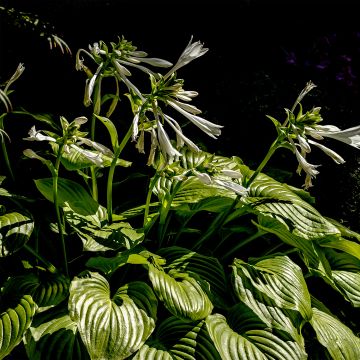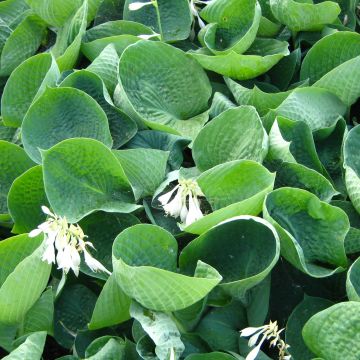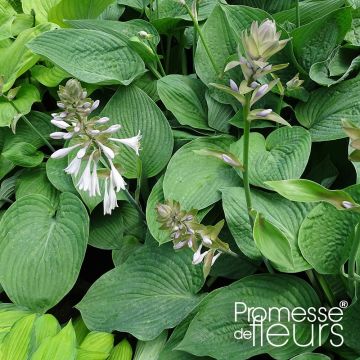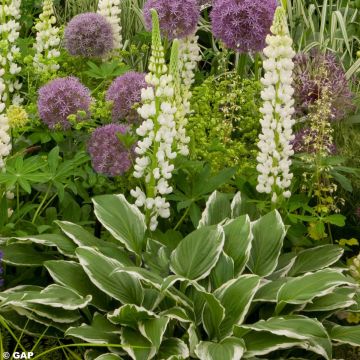

Hosta tardiana Blue Ivory


Hosta tardiana Blue Ivory
Hosta tardiana Blue Ivory
Hosta tardiana Blue Ivory
Plantain Lily, Funkia
Small young plant with beautiful roots and small leaves that match the photos well. Well packaged.
Christine G., 02/11/2018
This item cannot be shipped to the selected country
Delivery charge from €5.90
Delivery charge from €5.90
More information
Schedule delivery date,
and select date in basket
This plant carries a 12 months recovery warranty
More information
We guarantee the quality of our plants for a full growing cycle, and will replace at our expense any plant that fails to recover under normal climatic and planting conditions.
From €5.90 for pickup delivery and €6.90 for home delivery
Express home delivery from €8.90.
From €5.90 for pickup delivery and €6.90 for home delivery
Express home delivery from €8.90.

Does this plant fit my garden?
Set up your Plantfit profile →
Description
Hosta tardiana 'Blue Ivory' has something enchanting about it. This variety, also known as Funkia, is a natural mutation of the famous cultivar 'Halcyon'. Its astonishing cordate-elongated leaves, with a thick texture, show a blue central zone, adorned with metallic reflections, surrounded by an irregular ivory-white margin. They create a striking display from spring to autumn and come alive in July-August with a perfectly matched ashy-purple flowering. Of intermediate size and fairly slow growth, the plant establishes itself slowly and proves easy to succeed with in moist soil. 'Blue Ivory' is an exceptional perennial that will undoubtedly bring an almost unreal touch to the cool areas of the garden.
Hostas are deciduous perennial plants belonging to the Asparagaceae family. 'Blue Ivory' is part of a line of hybrids called 'tardiana'. This remarkable variety has the genes of Hosta tardiflora and H. sieboldiana var. elegans. 'Blue Ivory' forms a clump wider than it is tall after a few years. It will reach about 40cm (16in) in height and 50 to 60cm (20 to 24in) in diameter. This is a long-lived plant with deciduous foliage, which is mostly blue with greyish reflections. It maintains its intensity until late summer. The laminae are irregularly marginated with white. The leaves bear an elongated heart shape, ending in a sharp point. They have a smooth surface with prominent veins. This thick foliage resists gastropod attacks very well. Flowering takes place in July-August, in the form of compact pale-lavender bell-shaped pendulous spikes grouped towards the top of peduncles that can reach 55cm (22in) in height.
Originally from China, Korea, and Japan, hostas are very hardy plants. They are most often found as ground cover under deciduous trees, in cool beds or in rockeries and borders, especially near ornamental ponds. Hosta 'Blue Ivory' will blend well in partial shade with the blue or purple foliage of bugbanes, helxine, and the beautiful yellow leaves of alchemillas. It also pairs well with Claytonia sibirica, with which it forms beautiful colourful duos that require little maintenance. The bright and silvery foliage of Athyrium nipponicum 'Pictum' and Heuchera 'Sugar Frosting' will reveal all its brilliance. This perennial will also be at its best in the company of corydalis, tall foxgloves, or small violets. All hostas grow well in pots and can remain in the same container for several years. A special geranium potting soil should be used during the growing season. As long as the foliage is not too dense, watering can be done from the top of the pot. Then place a saucer under the pot where you will pour the water, keeping the level constant in summer.
Report an error about the product description
Hosta tardiana Blue Ivory in pictures


Flowering
Foliage
Plant habit
Botanical data
Hosta
tardiana
Blue Ivory
Liliaceae - Hostaceae
Plantain Lily, Funkia
Cultivar or hybrid
Other Hostas - Plantain Lilies
Planting and care
Plant in spring or autumn. They prefer deep, rich, humus-bearing, loose soil, preferably neutral to acidic (at least low in limestone), and moist to wet throughout the year. Plant them in partial shade or dappled shade and in a location sheltered from strong winds.
Prepare a planting hole measuring 20x20x20cm (8x8x8in). If your soil is heavy, mix equal parts compost with crumbled soil, partially fill the hole, and place your plant with its root ball so that the top of the root ball is covered with 3cm (1in) of soil. Applying a slow-release fertiliser (dehydrated blood, horn powder) will nourish your plant during its rooting period without the risk of burning. Make sure to position the collar well above ground level. Firm the soil and water thoroughly to remove any air pockets. In dry weather, water regularly for a few weeks to facilitate the establishment of your plant. Also, water regularly during dry summers.
With their common preference for moist areas, slugs and snails are never far away from hostas. Even though blue or variegated hostas often have thicker and tougher foliage, which is less appealing to slugs, these plants still need protection from gastropods. Protect your hostas by surrounding them with ferramol-based pellets (approved for organic agriculture), eggshells, coffee grounds, wood chips, or any dry and rough natural substance that repels them. Hedgehogs are the gardener's best allies in the fight against gastropods, as they do not disturb the soil and do not attack the lush green shoots of young plants. Slugs are also repulsed by plants with strong odours, such as wormwood and garlic.
Planting period
Intended location
Care
-
, onOrder confirmed
Reply from on Promesse de fleurs
Summer flowering perennials
Haven't found what you were looking for?
Hardiness is the lowest winter temperature a plant can endure without suffering serious damage or even dying. However, hardiness is affected by location (a sheltered area, such as a patio), protection (winter cover) and soil type (hardiness is improved by well-drained soil).

Photo Sharing Terms & Conditions
In order to encourage gardeners to interact and share their experiences, Promesse de fleurs offers various media enabling content to be uploaded onto its Site - in particular via the ‘Photo sharing’ module.
The User agrees to refrain from:
- Posting any content that is illegal, prejudicial, insulting, racist, inciteful to hatred, revisionist, contrary to public decency, that infringes on privacy or on the privacy rights of third parties, in particular the publicity rights of persons and goods, intellectual property rights, or the right to privacy.
- Submitting content on behalf of a third party;
- Impersonate the identity of a third party and/or publish any personal information about a third party;
In general, the User undertakes to refrain from any unethical behaviour.
All Content (in particular text, comments, files, images, photos, videos, creative works, etc.), which may be subject to property or intellectual property rights, image or other private rights, shall remain the property of the User, subject to the limited rights granted by the terms of the licence granted by Promesse de fleurs as stated below. Users are at liberty to publish or not to publish such Content on the Site, notably via the ‘Photo Sharing’ facility, and accept that this Content shall be made public and freely accessible, notably on the Internet.
Users further acknowledge, undertake to have ,and guarantee that they hold all necessary rights and permissions to publish such material on the Site, in particular with regard to the legislation in force pertaining to any privacy, property, intellectual property, image, or contractual rights, or rights of any other nature. By publishing such Content on the Site, Users acknowledge accepting full liability as publishers of the Content within the meaning of the law, and grant Promesse de fleurs, free of charge, an inclusive, worldwide licence for the said Content for the entire duration of its publication, including all reproduction, representation, up/downloading, displaying, performing, transmission, and storage rights.
Users also grant permission for their name to be linked to the Content and accept that this link may not always be made available.
By engaging in posting material, Users consent to their Content becoming automatically accessible on the Internet, in particular on other sites and/or blogs and/or web pages of the Promesse de fleurs site, including in particular social pages and the Promesse de fleurs catalogue.
Users may secure the removal of entrusted content free of charge by issuing a simple request via our contact form.
The flowering period indicated on our website applies to countries and regions located in USDA zone 8 (France, the United Kingdom, Ireland, the Netherlands, etc.)
It will vary according to where you live:
- In zones 9 to 10 (Italy, Spain, Greece, etc.), flowering will occur about 2 to 4 weeks earlier.
- In zones 6 to 7 (Germany, Poland, Slovenia, and lower mountainous regions), flowering will be delayed by 2 to 3 weeks.
- In zone 5 (Central Europe, Scandinavia), blooming will be delayed by 3 to 5 weeks.
In temperate climates, pruning of spring-flowering shrubs (forsythia, spireas, etc.) should be done just after flowering.
Pruning of summer-flowering shrubs (Indian Lilac, Perovskia, etc.) can be done in winter or spring.
In cold regions as well as with frost-sensitive plants, avoid pruning too early when severe frosts may still occur.
The planting period indicated on our website applies to countries and regions located in USDA zone 8 (France, United Kingdom, Ireland, Netherlands).
It will vary according to where you live:
- In Mediterranean zones (Marseille, Madrid, Milan, etc.), autumn and winter are the best planting periods.
- In continental zones (Strasbourg, Munich, Vienna, etc.), delay planting by 2 to 3 weeks in spring and bring it forward by 2 to 4 weeks in autumn.
- In mountainous regions (the Alps, Pyrenees, Carpathians, etc.), it is best to plant in late spring (May-June) or late summer (August-September).
The harvesting period indicated on our website applies to countries and regions in USDA zone 8 (France, England, Ireland, the Netherlands).
In colder areas (Scandinavia, Poland, Austria...) fruit and vegetable harvests are likely to be delayed by 3-4 weeks.
In warmer areas (Italy, Spain, Greece, etc.), harvesting will probably take place earlier, depending on weather conditions.
The sowing periods indicated on our website apply to countries and regions within USDA Zone 8 (France, UK, Ireland, Netherlands).
In colder areas (Scandinavia, Poland, Austria...), delay any outdoor sowing by 3-4 weeks, or sow under glass.
In warmer climes (Italy, Spain, Greece, etc.), bring outdoor sowing forward by a few weeks.
























































